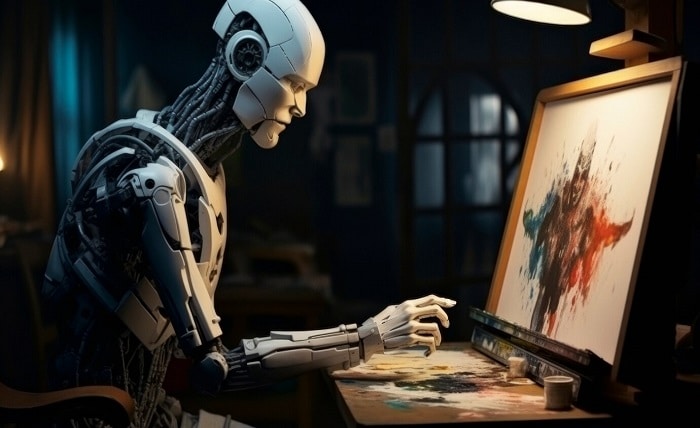
Artificial intelligence has already changed many industries, from health to finance. However, generative AI is one of the most exciting and contentious developments in recent times. Unlike traditional AI, which relies on algorithms to process and analyze existing data, generative AI can create new content from scratch—whether writing articles, composing music, designing artwork, or even generating realistic human voices.
It’s gaining steam in entertainment, marketing, gaming, and design, and it can disrupt the whole industry by automating creativity. The GPT-3 and DALL·E models of deep learning have sparked the imaginations of tech enthusiasts, creative professionals, and businesses and important questions regarding the future of human creativity, ethics, and intellectual property.
In this blog, we will discuss Generative AI, what it can do today, emerging exciting applications, the opportunities, and the challenges. We will discuss how businesses, creatives, and individuals can leverage this cutting-edge technology and prepare for the future. For niche knowledge, we’ll explore top educational routes like the MIT AI Certificate, PGDM in AI, and courses on Generative AI that help shape the next generation of AI professionals.
What is Generative AI?
Generative AI can be described as a class of AI algorithms. The algorithms generate new content based on patterns learnt from the data. This means that generative models can generate entirely new data, including images and videos, as well as other forms of creative content, from music to written text, including 3D models that almost look like work done by people.
This approach often involves complex deep learning architectures, such as Generative Adversarial Networks (GANs) and Transformer models. Such systems have been trained on vast datasets; they learn to identify the patterns, structures, and features of the data in it. When trained on data, an AI system can use such information to generate new, realistic content that simulates the data from which it learned.
Examples of generative AI systems include:
- GPT-3: A text-generating language model that creates human-like texts, from articles to poems, based on a simple prompt.
- DALL·E: An image generation model developed by OpenAI which generates novel images based on text descriptions.
- DeepFake Technology: A highly disputable application of generative AI to create videos and images of people doing things they never did in a completely hyper-realistic way.
Emerging Applications of Generative AI
With these possibilities, applications of generative AI are vast and broadening by the day into different sectors. Some of the most important ones include the following:
Content Creation and Writing
It is quite advanced technology regarding content creation, especially in writing. GPT-3 can create coherent, contextually relevant articles, blog posts, or creative fiction. The power of this technology will allow for drafts, summaries, or even full articles in a matter of time compared to what a human writer would require.
Companies and freelancers, now more than ever, are likely to depend upon the generative AI tools that are likely used to collaborate on marketing materials, ad copy, social media posting, and other items. The closer AI comes to perfection, the more significant the challenge it will be to distinguish human-written content from AI-generated content.
Art and Design:
It’s also causing ripples in the art and design world. DALL·E can create high-resolution, even fantastical images based on a simple textual prompt. Artists and designers use these AI apps to create original visual content-from logos and illustrations to full-fledged artworks. Tools like a free AI picture generator can inspire new visual concepts and streamline the creative process.
These AI-written compositions blur the lines between original thoughts and the author, leaving the question of what it means to be creative or authored by a machine. From idea generation to completion, artists have much to ask for creative help.
Composition of Music:
Generative AI has made remarkable progress in the field of music composition. Tools like OpenAI’s MuseNet and Amper Music allow users to create original music compositions based on specific genres, instruments, and moods. Musicians and producers can use these AI systems as creative collaborators, generating background music, instrumentals, or even full songs in minutes.
Generative AI in music allows artists to create sounds that, until recently, were impossible. Sometimes, AI will even compose music that is close to the works of great masters or contemporary authors. This innovation changes the whole music industry: faster production possibilities and stretching the creative bounds of artists.
Gaming and Virtual Worlds:
It is particularly transformational in the context of gaming. The developers of video games can apply generative models to create procedural content, maps, characters, or quests, which are different every time the player interacts with the game. This technology opens up the possibility of almost infinite variety in terms of game worlds and experiences.
It is something that some games, such as Minecraft and No Man’s Sky, have achieved because the game world extends as the player explores this world and offers limitless new environments that the players can discover.
Personalized Marketing and Advertising:
Another application of generative AI relates to personalized marketing. Analyzing user behavior and preferences, generative AI can build personalized advertisements, product recommendations, and marketing content that will speak more effectively with individual consumers.
For example, the generative models would generate dynamic ad creatives based on the audience it will reach, probably culled from browsing history or purchase behavior. The AI would take over tasks that required the human touch in one way or another – writing email marketing copy or designing social media ads.
Medical Research and Drug Discovery:
Generative AI has been used in health to design new drugs and medical treatments. By analysing molecular structures, AI will predict how compounds interact differently. Therefore, this means that it will propose new formulations of drugs for treating diseases. Such can hasten the drug discovery process; life-saving treatments are ensured to be developed and marketed.
With the emergence of generative models in medical imaging, AI-generated synthetic images may also serve as a teaching resource for doctors and other healthcare practitioners in making a diagnosis or designing the appropriate treatment.
Benefits and Opportunities through Generative AI
Generative AI presents numerous possibilities for any kind of commercial or artistic producer. The next paragraphs explore the most relevant and exciting opportunities in light of such revolutionary power:
- Increased Productivity: Businesses and creators will produce much more content thanks to the power of generative AI in content generation, with jobs that could take a few days to weeks turned into hours or minutes.
- Cost Efficiency: Generative AI helps companies save money by reducing human labour use for creative and design work. AI will produce content that would have taken a team.
- It could boost creativity because generative AI can be viewed as an instrument to advance human creativity. It does not supplant artists, writers, and designers but further expands the limits on creating new ideas that they would not have imagined otherwise.
- Personalization: Generative AI enables businesses to create related and relevant content for users based on what they like, do, or behave in a specific manner. This extent of personalization enhances the engagement and satisfaction of customers.
- Accelerating Innovation Speed: This way, Generative AI is helping speed up innovation in industries such as healthcare and technology by providing rapid prototyping, testing, and iteration of novel ideas or products.
Challenges and Ethical Issues
In the face of the promises that generative AI presents in different applications, several ethical issues and concerns are still pending:
- Intellectual Property Issues: Who owns the content that an AI has produced? Who owns the painting created by an AI model? The song or the novel? On the one hand, it is complicated; on the other hand, it is a question of vital importance in this age when that generated content will appear all over our industries, at least in entertainment and advertising.
- Bias in AI Models: The inherent problem with generative AI models is that they get trained on such vast datasets and, if biased in those, tend to reflect biases and, in some cases, even exacerbate those, especially of a racist or sexist nature. In short, it becomes hard to develop unbiased, fair, and inclusive models of AI.
- Job Displacement: While the generative AI promises efficiency and productivity gains simultaneously, it also threatens to displace jobs traditionally done with human creativity. Hence, writers, graphic designers, and musicians compete with AI for work, and one would question job security and the future of creative professions.
- Misuse and Misinformation: The misuse of deepfake technology has been viewed as problematic because it uses generative AI to produce videos that are so hyper-realistic that fake videos of political figures or celebrities can be created to spread misinformation and cause harm. This leads to how generative AI can be regulated and controlled.
Career Preparation in Generative AI
The more Generative AI penetrates different industries, the higher the demand for those skilled in it. Therefore, anyone looking to build a career in AI should consider specializing in machine learning, neural networks, and deep learning. Formal education or online generative AI courses can be very helpful, as direct hands-on experience working with AI tools and models is important.
The landscape of AI is changing, and avenues for professionals are being opened across sectors. A PGDM in AI could be a valuable combining both technical and business training that would enable such individuals to drive AI-based initiatives within their organizations. Dedicated courses on Generative AI prepare students to develop and implement these models, making the courses invaluable to anyone seeking specialization in creating AI content.
Future of Generative AI
Exciting yet uncertain is the future of generative AI; with the improved quality of AI models, generated content will become more complex, realistic, and creative. It will soon be applied in professions of all walks of life, revolutionising and unlocking new creative possibilities faster.
However, ethics, bias, and accountability will be challenges that need to be addressed as this technology becomes more integral to society. The frameworks for responsible use and ensuring that AI-generated content aligns with societal values can help us tap into the full potential of generative AI positively and constructively.




